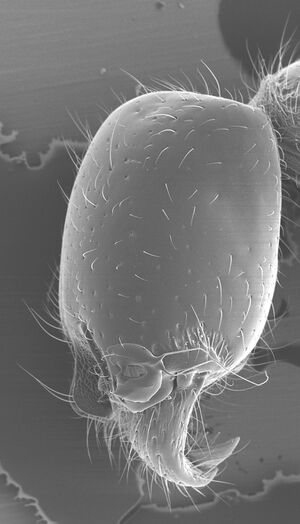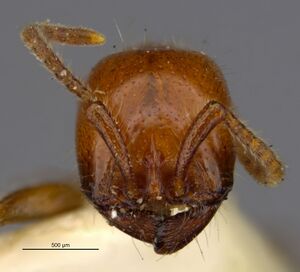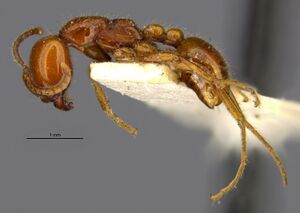Neivamyrmex agilis
| Neivamyrmex agilis | |
|---|---|

| |
| Scientific classification | |
| Kingdom: | Animalia |
| Phylum: | Arthropoda |
| Class: | Insecta |
| Order: | Hymenoptera |
| Family: | Formicidae |
| Subfamily: | Dorylinae |
| Genus: | Neivamyrmex |
| Species: | N. agilis |
| Binomial name | |
| Neivamyrmex agilis Borgmeier, 1953 | |
A Chihuahuan Desert species that is often found in riparian areas. Workers have been observed foraging in columns, several meters long, searching in the leaf litter and holes in the habitat. (Mackay and Mackay 2002)
Identification
Keys including this Species
Distribution
United States: southern AZ, NM (Grant Co). MEXICO: Chihuahua, Jalisco.
Latitudinal Distribution Pattern
Latitudinal Range: 34.50447° to 18.11944°.
| North Temperate |
North Subtropical |
Tropical | South Subtropical |
South Temperate |
- Source: AntMaps
Distribution based on Regional Taxon Lists
Nearctic Region: United States.
Neotropical Region: Mexico (type locality).
Distribution based on AntMaps
Distribution based on AntWeb specimens
Check data from AntWeb
Countries Occupied
| Number of countries occupied by this species based on AntWiki Regional Taxon Lists. In general, fewer countries occupied indicates a narrower range, while more countries indicates a more widespread species. |

|
Estimated Abundance
| Relative abundance based on number of AntMaps records per species (this species within the purple bar). Fewer records (to the left) indicates a less abundant/encountered species while more records (to the right) indicates more abundant/encountered species. |

|
Biology
Castes
The male and queen of this species are so far unknown, but we believe that Neivamyrmex andrei is the likely male. (Snelling and Snelling 2007)
Worker
     
| |
| . | |
   
| |
| . | Owned by Museum of Comparative Zoology. |
Images from AntWeb
   
| |
| Worker. Specimen code casent0102761. Photographer April Nobile, uploaded by California Academy of Sciences. | Owned by CAS, San Francisco, CA, USA. |
Nomenclature
The following information is derived from Barry Bolton's Online Catalogue of the Ants of the World.
- agilis. Neivamyrmex agilis Borgmeier, 1953: 44 (w.) MEXICO (Chihuahua).
- Type-material: holotype worker, 26 paratype workers.
- Type-locality: holotype Mexico: Chihuahua, Rio Santa Maria, 8.v. (C.H.T. Townsend); paratypes with same data.
- Type-depositories: MCZC (holotype); MCZC, MZSP (paratypes).
- Status as species: Borgmeier, 1955: 406 (redescription); Kempf, 1972a: 153; Watkins, 1972: 349 (in key); Hunt & Snelling, 1975: 20; Watkins, 1976: 17 (in key); Smith, D.R. 1979: 1330; Watkins, 1982: 211 (in key); Watkins, 1985: 482 (in key); Bolton, 1995b: 287; Mackay & Mackay, 2002: 53; Snelling, G.C. & Snelling, 2007: 466.
- Material of the nomen nudum cocula referred here by Borgmeier, 1955: 406; Kempf, 1972a: 153.
- Distribution: Mexico, U.S.A.
Unless otherwise noted the text for the remainder of this section is reported from the publication that includes the original description.
Description
References
- Alatorre-Bracamontes, C.E., Vásquez-Bolaños, M. 2010. Lista comentada de las hormigas (Hymenoptera: Formicidae) del norte de México. Dugesiana 17(1): 9-36.
- Borgmeier, T. 1953. Vorarbeiten zu einer Revision der neotropischen Wanderameisen. Stud. Entomol. 2: 1-51. (page 45, worker described)
- Borgmeier, T. 1955. Die Wanderameisen der neotropischen Region. Stud. Entomol. 3: 1-720 (page 406, Material of the nomen nudum cocula referred here.)
- Mackay, W.P. & Mackay, E.E. 2002. The Ants of New Mexico: 400 pp. Edwin Mellen Press, Lewiston, N.Y.
- Snelling, G. C.; Snelling, R. R. 2007. New synonymy, new species, new keys to Neivamyrmex army ants of the United States. In Snelling, R. R., B. L. Fisher, and P. S. Ward (eds). Advances in ant systematics (Hymenoptera: Formicidae): homage to E. O. Wilson - 50 years of contributions. Memoirs of the American Entomological Institute 80:459-550. PDF
- Varela-Hernández, F., Medel-Zosayas, B., Martínez-Luque, E.O., Jones, R.W., De la Mora, A. 2020. Biodiversity in central Mexico: Assessment of ants in a convergent region. Southwestern Entomologist 454: 673-686.
References based on Global Ant Biodiversity Informatics
- Borgmeier T. 1955. Die Wanderameisen der neotropischen Region. Studia Entomologica 3: 1-720.
- Cover S. P., and R. A. Johnson. 20011. Checklist of Arizona Ants. Downloaded on January 7th at http://www.asu.edu/clas/sirgtools/AZants-2011%20updatev2.pdf
- Dattilo W. et al. 2019. MEXICO ANTS: incidence and abundance along the Nearctic-Neotropical interface. Ecology https://doi.org/10.1002/ecy.2944
- Fernandes, P.R. XXXX. Los hormigas del suelo en Mexico: Diversidad, distribucion e importancia (Hymenoptera: Formicidae).
- Johnson R. Personnal Database. Accessed on February 5th 2014 at http://www.asu.edu/clas/sirgtools/resources.htm
- Kempf, W.W. 1972. Catalago abreviado das formigas da regiao Neotropical (Hym. Formicidae) Studia Entomologica 15(1-4).
- Mackay W. P., and E. E. Mackay. 2002. The ants of New Mexico (Hymenoptera: Formicidae). Lewiston, New York: Edwin Mellen Press, 400 pp.
- Quiroz-Robledo, L.N. and J. Valenzuela-Gonzalez. 2006. Las hormigas Ecitoninae (Hymenoptera: Formicidae) de Morelos, México. Revista Biologia Tropical 54(2):531-552
- Rojas Fernandez P. 2010. Capítulo 24. Hormigas (Insecta: Hymenoptera: Formicidae). In: Diversidad Biológica de Veracruz. Volumen Invertebrados. CONABIO-Gobierno del Estado de Veracruz.
- Snelling G. C. and R. R. Snelling. 2007. New synonymy, new species, new keys to Neivamyrmex army ants of the United States. Memoirs of the American Entomological Institute 80: 459-550
- Vasquez Bolanos M. 1998. Hormigas (Hymenoptera: Formicidae) colectadas en necrotrampas, en tres localidades de Jalisco, Mexico. Thesis in Biological Science, Las Aguijas, Zapopan, Jalisco, 61 pages.
- Vásquez-Bolaños M. 2011. Lista de especies de hormigas (Hymenoptera: Formicidae) para México. Dugesiana 18: 95-133
- Watkins II, J.F. 1982.The army ants of Mexico (Hymenoptera: Formicidae: Ecitoninae). Journal of the Kansas Entomological Society 55(2): 197-247.



